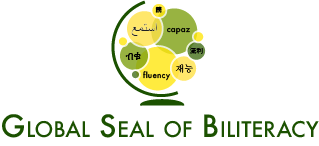Language Proficiency Self Assessment
The Global Seal of Biliteracy has developed a free adaptive language proficiency self assessment based on the commonly used NCSSFL-ACTFL Can-Do Statements. These can-do statements are reflective of an individual’s language ability based on the ACTFL Language Proficiency Levels.
The ACTFL Proficiency Guidelines organize how language learners are rated by what they are able to do into five categories: Novice, Intermediate, Advanced, Superior and Distinguished. To help measure the abilities of language learners, the ACTFL Performance Descriptors for Language Learners focuses on what learners in the first three levels (Novice, Intermediate, Advanced) are able to do. Language skills are further broken down into three “Communicative Modes,” which describe the language user’s purpose for using the specific skills of reading, listening, writing or speaking.
Interpretive Language Assessments
The Interpretive Mode of Communication describes the act of understanding or interpreting language that is heard, read or viewed. In this mode, language skill is measured by how well the language of an author, speaker, presenter or producer is understood. At higher levels, this understanding includes the ability to infer meaning or “read between the lines” based on cultural norms or perspectives. The Interpretive Mode includes a variety of language skills such as reading (books, articles, websites, brochures), listening (speeches, podcasts, songs) and viewing (movies, videos, theater plays). To summarize, the Interpretive Mode is one-way receptive communication.
Interpersonal Language Assessments
The Interpersonal Mode of Communication describes back and forth communication between individuals. Interpersonal communication could take place in either a written or spoken form, and implies that an “active negotiation of meaning” is taking place. Each participant actively observes and monitors the other’s communication and responds appropriately. Questions are followed by answers and/or clarifying statements. Listening comprehension is evidenced by a corresponding logical response. Written examples include letters, emails, texts, or written notes or messages that require reading and writing skills. Spoken examples may include face-to-face, telephone/video conversations or interviews. To summarize, the Interpersonal Mode is two-way active communication.
Presentational Language Assessments
The Presentational Mode of Communication describes the ability to create and produce written or spoken language for others in the form of messages designed to inform, persuade, explain or narrate. In this mode, language skill is measured by how much and how well the user can communicate in order to be understood. At higher levels, the Presentational Mode includes the ability to adapt to the formality of the situation and to use appropriate cultural and colloquial phrases. The Presentational mode includes writing (books, articles, reports), speaking (speeches, telling a story, giving a report) or a multi-mode presentation (theater/movie acting, a PowerPoint presentation, video voiceover). To summarize, the Presentational Mode is one-way productive communication.
*These language proficiency self assessments are to give you a rough estimate of where you might fall on the ACTFL Proficiency Scale. Your results are an approximation based solely on your answers and not to be used in place of a proficiency test.
